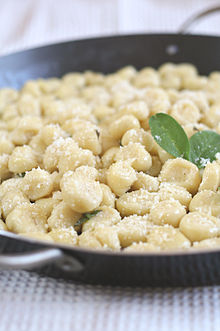Gnocchi: Difference between revisions
Luckas-bot (talk | contribs) m r2.7.1) (Robot: Adding id:Gnocchi |
|||
| Line 48: | Line 48: | ||
* [http://www.happystove.com/recipe/53/How+to+make+Potato+Gnocchi Homemade Potato Gnocchi Recipe] |
* [http://www.happystove.com/recipe/53/How+to+make+Potato+Gnocchi Homemade Potato Gnocchi Recipe] |
||
* [http://www.annamariavolpi.com/page80.html Step-by-Step Illustrated Gnocchi Recipe] |
* [http://www.annamariavolpi.com/page80.html Step-by-Step Illustrated Gnocchi Recipe] |
||
* [http://www.ostematto.it/primi-di-terra/466-gnocchi-al-radicchio-e-formaggi.html ''Gnocchi al radicchio e formaggi''/Gnocchi with red chicory and cheese recipe] {{it}} |
|||
* [http://www.ostematto.it/primi-di-terra/129-gnocchi-alla-romana.html ''Gnocchi alla romana'' recipe] {{it}} |
|||
* [http://www.ostematto.it/primi-di-terra/442-gnocchi-con-barbabietola-e-robiola.html ''Gnocchi con barbabietola e robiola''/Gnocchi with beet and Robiola cheese recipe] {{it}} |
|||
* [http://http://www.ostematto.it/primi-di-terra/124-gnocchi-di-patate-al-sugo.html ''Gnocchi al sugo di pomodoro e salsiccia''/Gnocchi with tomato sauce and sausage recipe] {{it}} |
|||
* [http://www.ostematto.it/primi-di-terra/125-gnocchi-di-patate-con-la-fontina.html ''Gnocchi con la fontina''/Gnocchi with fontina cheese recipe] {{it}} |
|||
{{Potato dishes}} |
{{Potato dishes}} |
||
Revision as of 10:40, 11 November 2011





- For the Italian Baroque composer, please see Pietro Gnocchi.
Gnocchi (/ˈnɒki/, /ˈnjɒki/; Italian: [ˈɲɔkki], singular gnocco) are various thick, soft dumplings. They may be made from semolina,[1] ordinary wheat flour,[2] flour and egg,[3] flour, egg, and cheese,[4] potato,[5] bread crumbs,[6] or similar ingredients.[7][8][9] The smaller forms are called gnocchetti.
Like many Italian dishes, there is considerable variation in recipes and names across different regions. For example, the Tuscan malfatti are a sort of flour, ricotta, and spinach gnocchi;[10] the Pugliese cavatielli are flour-based, and so on.[11]
Gnocchi are eaten as a first course (primi piatti), alternatives to soups (minestre), or pasta. They are widely available dried, frozen, or fresh in vacuum sealed packages in supermarkets and specialty stores. Classic accompaniments of gnocchi include tomato sauces, pesto, and melted butter (sometimes fried butter) with cheese.
While they are often available frozen in specialty grocers, they are typically homemade in Italian and Italian-American households.
Origin
The word gnocchi may derive from the Italian word nocchio, meaning a knot in wood,[12] or from nocca (meaning knuckle).[13] It has been a traditional Italian pasta type of probably Middle Eastern origin since Roman times.[14] It was introduced by the Roman Legions during the enormous expansion of the empire into the countries of the European continent. In the past 2,000 years, each country developed its own specific type of small dumplings, with the ancient gnocchi as their common ancestor. In Roman times, gnocchi were made from a semolina porridge-like dough mixed with eggs, and are still found in similar forms today, particularly Sardinia's malloreddus (although they do not contain eggs).
The use of potato is a relatively recent innovation, occurring after the introduction of the potato to Europe in the 16th century.[15] Potato gnocchi are particularly popular in Abruzzo, Ciociaria and other provinces of Latium; they are better prepared with red potatoes[citation needed].
Regional varieties
One variety, gnocchi di pane (literally "bread lumps"), derived from the Semmelknödel, is made from bread crumbs and is popular in Friuli and Trentino-Alto Adige/Südtirol. Another variety from the latter region is spinach gnocchi.
In Croatia
Gnocchi are very popular and often served dish in coastal Croatia, typically being served as a first course or a side dish with Dalmatinska pašticada.
In France
The name is also used in France in the dish known as "gnocchis à la parisienne", a hot dish comprising gnocchi formed of choux pastry, and served with Béchamel sauce.
In Argentina, Brazil and Uruguay
Because of the significant number of Italian immigrants that arrived in these countries gnocchi, ñoqui as it is called in Spanish or nhoque in Portuguese, is a very popular plate. The popularity of this Italian plate reflects on the tradition of eating them on the 29th of each month and some people put money under their plate as the tradition says it will give prosperity to the commensal.
See also
References
- ^ Vincenzo Buonassisi, Il nuovo codice della pasta, Rizzoli 1985, recipe #850-853
- ^ Buonassisi, recipe #831-833
- ^ Buonassisi, recipe #837-838
- ^ Buonassisi, recipe #839-840
- ^ Buonassisi, recipe #854-857
- ^ Buonassisi, recipe #877 "Al Pien... si tratta di gnocchi, delicatissimi, secondo un'antica ricetta mantovana..."
- ^ Waverley Root, The Food of Italy, 1971 passim
- ^ Luigi Carnacina, Luigi Veronelli, La cucina rustica regionale (4 vol.), Rizzoli 1966, passim
- ^ Accademia Italiana della Cucina, La Cucina: The Regional Cooking of Italy, tr. Jay Hyams, Rizzoli, 2009, passim
- ^ Buonassisi, recipe #875
- ^ Buonassisi, recipe #895
- ^ [[Oxford English Dictionary]], 2nd Edition. Oxford University Press. 1989.
{{cite book}}: URL–wikilink conflict (help) - ^ Lo Zingarelli, 2008.
- ^ Serventi, Silvano (2002). Pasta: The Story of a Universal Food. Trans. Antony Shugaar. New York: Columbia University Press. p. 17. ISBN 0231124422.
{{cite book}}: Unknown parameter|coauthors=ignored (|author=suggested) (help) - ^ Theisen, K. "World Potato Atlas: China - History and Overview". International Potato Center.
- Notes
- Davidson, Alan. The Oxford Companion to Food, s.v. gnocchi.
- Jenkins, Nancy Harmon. Flavors of Tuscany. 1998.
External links
![]() Media related to Gnocchi at Wikimedia Commons
Media related to Gnocchi at Wikimedia Commons
- Gnocchi Recipe, with video
- Gnocchi Recipe
- Homemade Potato Gnocchi Recipe
- Step-by-Step Illustrated Gnocchi Recipe
- Gnocchi al radicchio e formaggi/Gnocchi with red chicory and cheese recipe Template:It
- Gnocchi alla romana recipe Template:It
- Gnocchi con barbabietola e robiola/Gnocchi with beet and Robiola cheese recipe Template:It
- Gnocchi al sugo di pomodoro e salsiccia/Gnocchi with tomato sauce and sausage recipe Template:It
- Gnocchi con la fontina/Gnocchi with fontina cheese recipe Template:It
